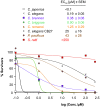Phylogenomics of ligand-gated ion channels predicts monepantel effect
- PMID: 20838602
- PMCID: PMC2936538
- DOI: 10.1371/journal.ppat.1001091
Phylogenomics of ligand-gated ion channels predicts monepantel effect
Abstract
The recently launched veterinary anthelmintic drench for sheep (Novartis Animal Health Inc., Switzerland) containing the nematocide monepantel represents a new class of anthelmintics: the amino-acetonitrile derivatives (AADs), much needed in view of widespread resistance to the classical drugs. Recently, it was shown that the ACR-23 protein in Caenorhabditis elegans and a homologous protein, MPTL-1 in Haemonchus contortus, are potential targets for AAD action. Both proteins belong to the DEG-3 subfamily of acetylcholine receptors, which are thought to be nematode-specific, and different from those targeted by the imidazothiazoles (e.g. levamisole). Here we provide further evidence that Cel-ACR-23 and Hco-MPTL-1-like subunits are involved in the monepantel-sensitive phenotype. We performed comparative genomics of ligand-gated ion channel genes from several nematodes and subsequently assessed their sensitivity to anthelmintics. The nematode species in the Caenorhabditis genus, equipped with ACR-23/MPTL-1-like receptor subunits, are sensitive to monepantel (EC(50)<1.25 µM), whereas the related nematodes Pristionchus pacificus and Strongyloides ratti, which lack an ACR-23/MPTL-1 homolog, are insensitive (EC(50)>43 µM). Genome sequence information has long been used to identify putative targets for therapeutic intervention. We show how comparative genomics can be applied to predict drug sensitivity when molecular targets of a compound are known or suspected.
Conflict of interest statement
L.R. and R.K. are employed by Novartis AH, which has developed monepantel. The use of AADs for veterinary purposes is patented (WO2002049641).
Figures



References
-
- Perry BD, Randolph TF. Improving the assessment of the economic impact of parasitic diseases and of their control in production animals. Vet Parasitol. 1999;84:145–168. - PubMed
-
- Drudge JH, Leland SE, Jr, Wyant ZN. Strain variation in the response of sheep nematodes to the action of phenothiazine. II. Studies on pure infections of Haemonchus contortus. Am J Vet Res. 1957;18:317–325. - PubMed
-
- Atanasio A, Boomker J, Sitoe C. A survey on the occurrence of resistance to anthelmintics of gastrointestinal nematodes of goats in Mozambique. Onderstepoort J Vet Res. 2002;69:215–220. - PubMed
-
- Coles GC, Rhodes AC, Wolstenholme AJ. Rapid selection for ivermectin resistance in Haemonchus contortus. Vet Parasitol. 2005;129:345–347. - PubMed
-
- Jackson F, Coop RL. The development of anthelmintic resistance in sheep nematodes. Parasitology. 2000;120(Suppl):S95–107. - PubMed
Publication types
MeSH terms
Substances
LinkOut - more resources
Full Text Sources
Other Literature Sources

